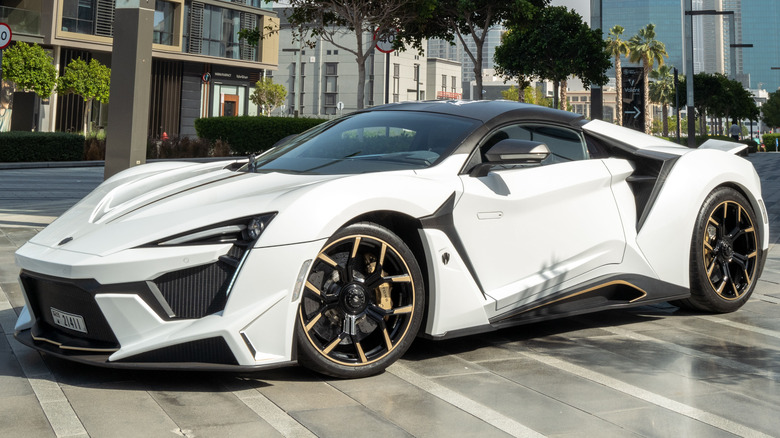
Bloomberg/Getty Images
According to research from Cox Automotive – informed by data provided by Kelley Blue Book – the average new car price in December 2023 was $48,759. That represents a slight decline from the same period the previous year but is still a steep premium compared to pre-pandemic averages. While overall car market price growth seems to be plateauing, the very top of the market continues to rise. Buyers looking for ultra high-end vehicles over $500,000 are spoilt for choice, with a wide range of cars from all-terrain luxury SUVs to face-meltingly fast EV hypercars to pick from.
Alongside the usual luxury marques that enthusiasts might expect to see at the very top of the automotive price list, a number of upstart brands have also found their way to the top of the table in recent years. Some offer high-end electric cars with outrageous four-figure power outputs, while others tout unique design and hyper-exclusivity as the reasons for their high asking prices. Whether they’re from ambitious startups or long-established legacy automakers, here are 12 of the most expensive cars currently for sale in 2024.
Rolls-Royce Phantom EWB – $573,000
Rolls-Royce’s flagship limousine is still the gold standard when it comes to ultra-luxury automobiles, and as you’d expect, it comes with a suitably high starting price. Exact numbers can be hard to pin down -– Phantoms are usually extensively customized by their owners, which significantly changes the final bill -– but Car and Driver reports that an extended wheelbase Phantom will cost at least $573,000. In EWB form, the Phantom’s already capacious interior is made even more palatial, with extra legroom for the rear VIP occupants.
There was once a time when Rolls-Royce refused to disclose its cars’ power figures, famously describing the output of its Silver Shadow as «adequate.» However, times have moved on, and today the company is much more forthcoming about what’s under the hood. Every example is powered by a twin-turbocharged V12 making 563 horsepower, which is enough to trim the car’s 0-60 time down to 5.1 seconds. Even at full throttle, the car’s ride is meticulously engineered to be as smooth as possible, with a system of cameras and sensors to detect the road ahead and adjust the suspension to offset any bumps or potholes.
Combine that otherworldly ride with a laundry list of lavish optional extras – including a built-in champagne cooler and a Shooting Star Headliner — and it’s easy to see why the Phantom remains the ride of choice for the world’s richest businesspeople.
Ferrari SF90 Spider – $575,000
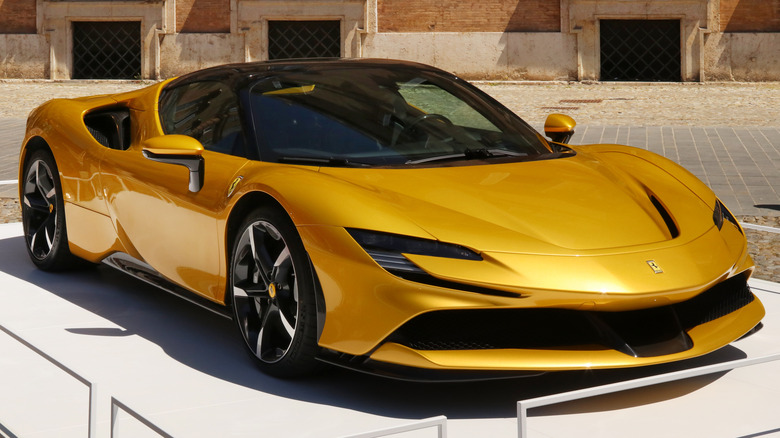
Fabrizio Annovi/Shutterstock
With a starting price of $575,000, the Ferrari SF90 Spider is one of the most expensive series production Prancing Horses to date. However, the rising price hasn’t stopped well-heeled collectors from queueing to get their hands on one -– quite the opposite, in fact. The brand posted record sales figures in 2022, with the SF90 cited as one of the key reasons for the growth.
The hardtop version of the car, the SF90 Stradale, is slightly cheaper, with a starting price of around $524,000. Both sport a 0-60 mph time of 2.5 seconds and a top speed of 211 mph, made possible thanks to the new hybrid powertrain. Of the total 986 horsepower on offer, 769 horses are produced by the 4.0L twin-turbo V8 engine. The remaining 217 horsepower comes courtesy of the twin electric motors, which pair with a 7.9 kWh battery pack for up to 16 miles of all-electric range.
However, actually purchasing an SF90 Spider isn’t a case of simply heading to the nearest dealership and handing over the cash. With so much interest, new customers will be at the back of a very long waitlist. There is a long list of rules that owners follow to boost themselves further up the queue, but unless they’re already a VIP customer, it’s extremely unlikely they’ll be able to bag a 2024 build slot.
Lamborghini Revuelto – $600,000
After much fanfare, Lamborghini’s Aventador successor was unveiled in 2023. The headline feature is the new powertrain, as the Raging Bull’s flagship is no longer a gas-only affair, with three electric motors working alongside its V12 engine to deliver a combined 1,001 horsepower. Our first drive of the Revuelto confirmed that the added power was more than just impressive on paper –- the low-end torque from the electric motors made high-speed cornering easier than ever. Equally impressive was the steering feel, which we thought was sharper than the outgoing Aventador.
With an official top speed of more than 217 mph and a 0-62 time of 2.5 seconds, the Revuelto’s performance figures are very close to that of its Ferrari rival, the SF90 Stradale, but it’s the Lambo that’ll require slightly deeper pockets, though, as the Revuelto starts at $600,000. However, unlike the SF90, it’s only available in hardtop form for now. It’s extremely likely that a roadster version will appear in the coming years, most likely with an even higher price tag.
For now, though, Lamborghini will be focusing on meeting customer demand for the regular Revuelto, as it was reported in October 2023 that the waitlist for the car had exceeded 30 months.
Radford Type 62-2 – $636,000
From rather unconventional beginnings, boutique carmaker Radford has created what’s arguably one of the best-looking supercars you’ve probably never heard of. The brand was founded by a small group of entrepreneurs, including Ant Anstead, a British TV presenter best known for «Wheeler Dealers,» and Jenson Button, a former F1 world champion. It takes the chassis of a Lotus Exige and overhauls almost every element, with the resulting car longer, lower, and much more powerful than any Exige.
In top-spec form, there’s up to 605 horsepower on offer thanks to a 3.5L supercharged V6. The minimalist, race-focused interior is designed with weight saving in mind, featuring only the bare necessities. Of course, the one exception is the dual dash-mounted stopwatches, made by luxury watchmaker Bremont, which are available as an optional extra. The car’s styling is inspired by the Lotus Type 62 racer of the late ’60s, and two retro-liveried specials are available to pay tribute to the original.
There’s a John Player Special edition of the car and a Gold Leaf edition, both of which are limited to just 12 units. The entire production run is capped at 62 units, with prices varying based on variant and power output. Radford has yet to confirm exact prices, but Top Gear reported that the full-fat 605 horsepower version will cost around £500,000, which equates to roughly $636,000 at the time of this writing.
Brabus 900 XLP – $909,000
German tuner Brabus produces some of the most outlandish modified Mercedes-AMGs on the market, with the 900 XLP being among the priciest. It’s based on the Mercedes-AMG G 63 but boasts a long list of upgrades, including boosting power output to 900 horsepower. This is achieved by increasing the displacement of the G-Wagon’s stock V8, fitting two Brabus-designed turbochargers, and installing a new ECU, among other tweaks. The power boost brings the car’s 0-60 mph time down to just 4.4 seconds, although the top speed is capped at 130 mph.
Although the tuner doesn’t specify why the car’s top speed is limited to a lower speed than a standard G63, it’s safe to assume that it’s down to the off-road ready body kit and beefy all-terrain tires. The Brabus is both higher and wider than a standard SUV, and it can also be fitted with a roof rack and a winch for more remote adventures. Plus, the pickup bed conversion makes it easy to bring kit and supplies along for the ride.
Like many ultra-expensive cars, Brabus doesn’t disclose exact pricing, but at the time of writing, the brand lists a nearly-new example of the 900 XLP on its website for 830,968 Euros — which is around $909,000.
SSC Tuatara – $1.6 million
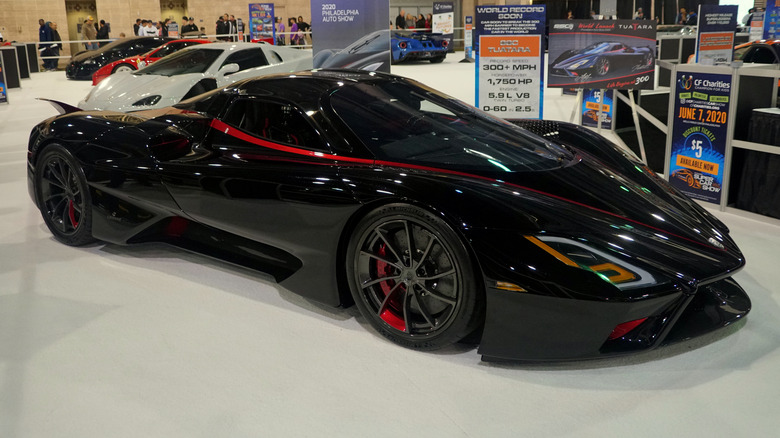
Khairil Azhar Junos/Shutterstock
Modern hypercars are often announced in very limited runs, with most or all of their order book filled by a brand’s loyal clients long before their public unveiling. This means finding one that’s actually available to buy is no easy task. Most exotics unveiled before they’re sold out are built by smaller manufacturers who don’t have the luxury of a long-existing client base. One such brand is SSC, with its latest hypercar being the $1.6 million Tuatara. The Tuatara drew headlines in 2020 when its maker announced that it had set the production car speed record, reaching 316.11 mph on a closed section of highway in Nevada.
Further, independent scrutiny by experts cast doubt on those claims, and the run was never certified by Guinness World Records. A second attempt, this time on a much shorter runway, saw the car reach a two-way average of 282.9 mph –- highly impressive, no doubt, but nowhere near the claimed original figure. Nonetheless, observers at the event noted that it was the length of the runway that limited the car’s top speed, not the car itself.
Further attempts will no doubt be planned to try and vindicate the car’s 300 mph+ claims, but the controversy surrounding it means that the planned 100-unit run is yet to sell out for now. That makes it quite possibly the fastest car still available to buy, even if it’s not officially the fastest ever made.
W Motors Fenyr SuperSport – $1.9 million
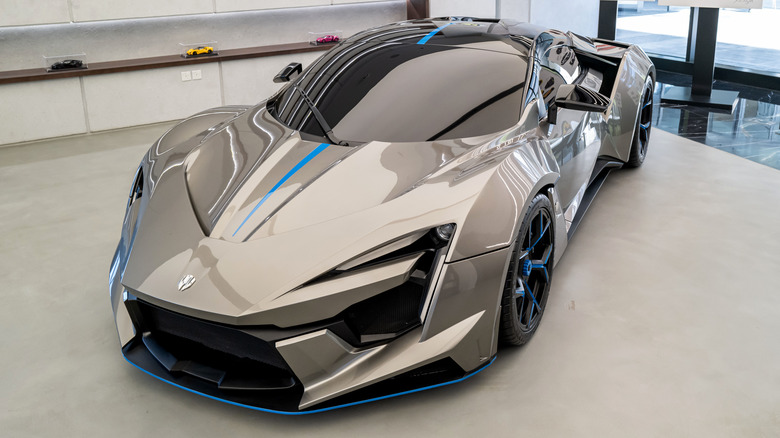
Bloomberg/Getty Images
After the success of the Lykan HyperSport, UAE-based W Motors was quick to follow its debut car up with another, slightly less eye-wateringly expensive offering. While the Lykan HyperSport started at $3.4 million, the Fenyr SuperSport costs $1.9 million — still hardly what most people would consider a bargain. The SuperSport was first unveiled in 2017 but it took two years for the launch edition to sell out. This ultra-exclusive run of just 10 cars is made even more exclusive by the fact that a single Japanese collector reportedly purchased five of those specials in one transaction.
Billionaires with seven-figure sums burning a hole in their pockets don’t need to worry though, as W Motors plans to build a further 100 examples of the car after the initial launch run. Each one features an 800 horsepower 3.8L flat-six engine built by Porsche specialists RUF. The sprint from 0-60 takes just 2.8 seconds, while the officially claimed top speed is 248 mph. If a standard Fenyr seems just a little too common, then W Motors also offers an extensive customization program where buyers can add their own personal touches –- all at an added cost, of course.
Koenigsegg Gemera HV8 – $2.1 million
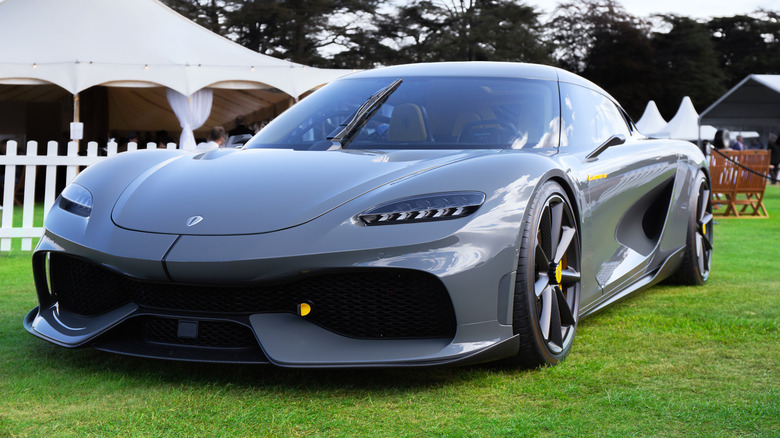
Martyn Lucy/Getty Images
Despite promising to step away from chasing top speed records with the launch of the Jesko Absolut, Koenigsegg is still very much in the business of making absurdly fast cars. The four-seater Gemera is one of its latest creations, with a hybrid setup featuring an inline-three cylinder as standard and an option for a hybrid V8.
The latter is the most expensive of the two, costing a reported $2.1 million, around $400,000 more than the base Gemera. It’s also the most powerful of the group, with 2,300 horsepower combined output, 1,500 of which is delivered by the combustion engine. In its standard three cylinder hybrid form, the Gemera delivers a still-exceptional 1,400 combined horsepower. So, a four-figure power output from a hybrid with one less cylinder than a Prius.
As well as being extremely fast, the Gemera is also Koenigsegg’s most practical car to date, with room for four adults and a token amount of luggage. Production is set to be limited to 300 units across all variants, although it’s not known how many build slots for the car remain.
Rimac Nevera – $2.2 million
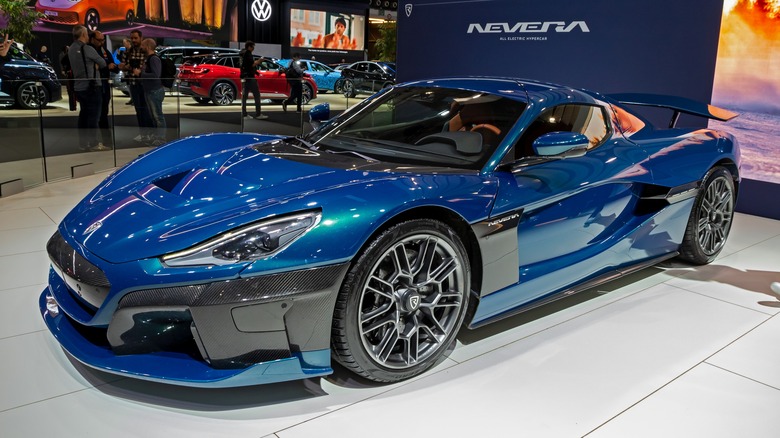
VanderWolf Images/Shutterstock
With a number of electric hypercars now claiming horsepower outputs that would have seemed unthinkable just a decade or two ago, it’s easy to forget just how extreme a car this powerful is to drive. We spent some time behind the wheel of the Rimac Nevera Time Attack, a special variant of the Croatian hypercar limited to just 12 units, and left questioning whether a non-professional racing driver could even cope with driving something more powerful at its limits. The Nevera Time Attack is already sold out, but the standard Nevera remains available for now, with a starting price of around $2.2 million.
The Nevera produces 1,813 horsepower from four electric motors and boasts a 0-60 mph time of just 1.85 seconds. It can officially reach a top speed of 258 mph, and — thanks to its unrelenting acceleration — it will hit high triple digit speeds quicker than almost any other production car on the planet. Straight-line speed is one thing, but the Nevera also excels in the corners, both on the road and on the track. There’s also a drift mode available for sideways thrills.
The Nevera is capped at 150 units overall, and to date, Rimac has remained tight-lipped about exactly how many build slots are left. A recently announced distribution partnership with VW Group of America will likely provide a sales boost for any remaining units, so deep-pocketed EV enthusiasts won’t have long to secure a slot.
Gordon Murray Automotive T.33 Spider – $2.3 million
The designer of the McLaren F1, Gordon Murray, unveiled his most famous car’s spiritual successor in 2020. Christened the GMA T.50, the car sold out extremely quickly after launch, as did later GMA models, the T.50s and T33. A notice on the Gordon Murray website declares that it’s now too late for collectors to get their hands on any of those exclusive cars, but as of this writing, it’s still possible to register interest in the T.33 Spider.
It’s limited to 100 units, and by the time of its unveiling in 2023 close to half the production run had reportedly been sold. Much like the T.33 coupe, the Spider features a 3.9L Cosworth-built V12 engine making 607 horsepower. That V12 is naturally aspirated and redlines at 11,100 rpm. That might not be quite as lofty as the T.50, but it’s still enough to give the T.33 Spider a soundtrack that will be completely different from any other sports car of its size.
The T.33 Spider is also designed to be better suited for long road trips than other seven-figure supercars, with 10.4 cubic feet of luggage space and Apple CarPlay and Android Auto for navigation and entertainment. It starts at £1.8 million — which is roughly $2.3 million — and the first examples aren’t set to be delivered until well into 2025.
Deus Vayanne – $2.5 million
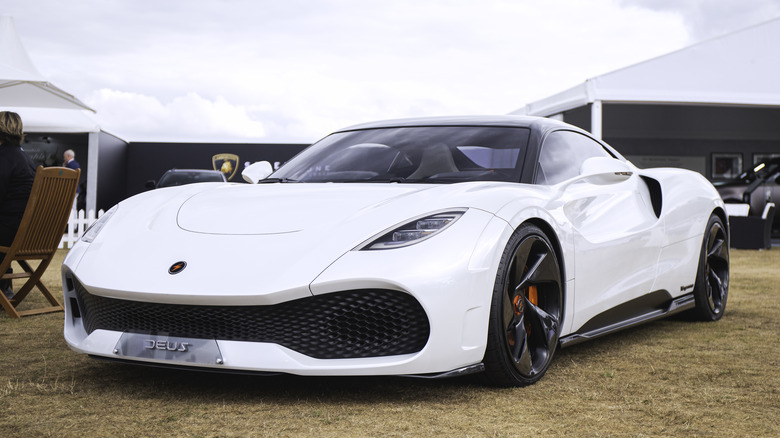
Martyn Lucy/Getty Images
Launched at the 2022 New York International Auto Show, the Vayanne is the first car from the Austrian supercar startup Deus. Ambitious car startups are a dime a dozen, but Deus does boast some notable partnerships that put its chances of production a cut above most. For example, its founders have inked a deal with Italdesign to build cars in its facility in Turin, Italy, from 2025. Italdesign’s factory has previously built everything from the BMW M1 to the recent Nissan GTR-50, and also the brand’s own limited-run hypercar, the Zerouno.
Also partnered with Deus is William Advanced Engineering, a former division of the Williams F1 team that now operates as a standalone EV specialist. As the main supplier of batteries in a variety of motorsport disciplines from Formula E to the WEC Hypercar (LMDh) class, Williams has plenty of prior experience making world-beating EV powertrains.
Since the car is still in development, final performance figures haven’t been pinned down, but the car’s provisional power output stands at 2,243 horsepower, with a 0-60 mph time of less than two seconds and a top speed in excess of 250 mph. Also yet to be confirmed is the exact starting price, although a figure of $2.5 million has been previously reported by Autocar.
Lotus Evija – $2.6 million
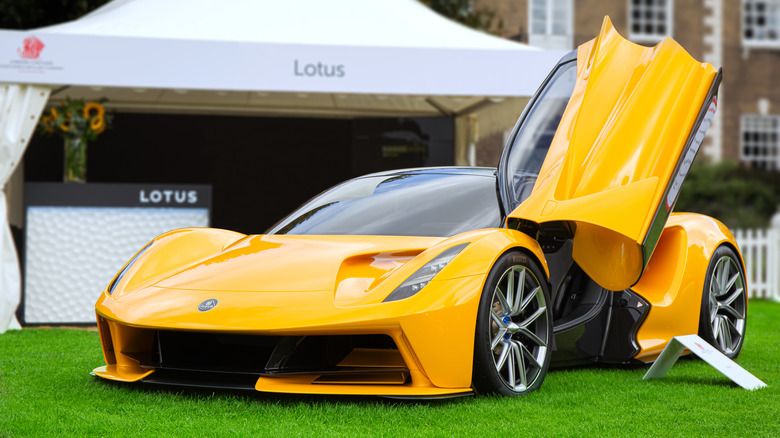
Martyn Lucy/Getty Images
The most expensive and most powerful Lotus road car ever made has been on the market for a number of years now, first being unveiled back in 2019. At launch, it was reported to cost $2.15 million, with a production run capped at 130 units. However, production delays coupled with the impact of the pandemic meant that it took until 2023 for the first examples to be delivered to customers, with the handovers being conducted at the Monterey Car Week. While a series of reports in 2020 claimed that the initial year’s production run had sold out, it seems a few of the later build slots remain unsold.
A 2023 report by CarBuzz claimed that an unspecified number of Evija build slots were still available, with a revised price of $2.6 million. The configurator is also still live on the brand’s website, so it seems for now, the Evija takes the crown as the most expensive new car currently on public sale.
When the Evija first debuted it was groundbreaking, with nearly 2,000 horsepower on offer and a range of around 250 miles. More recent hypercar arrivals have meant those numbers are no longer quite so unique, but they’re still mightily impressive nonetheless. Whether the last few slots will be shifted now that production is in full swing remains to be seen, but for now, the Lotus is just about the most expensive new car on sale in 2024.